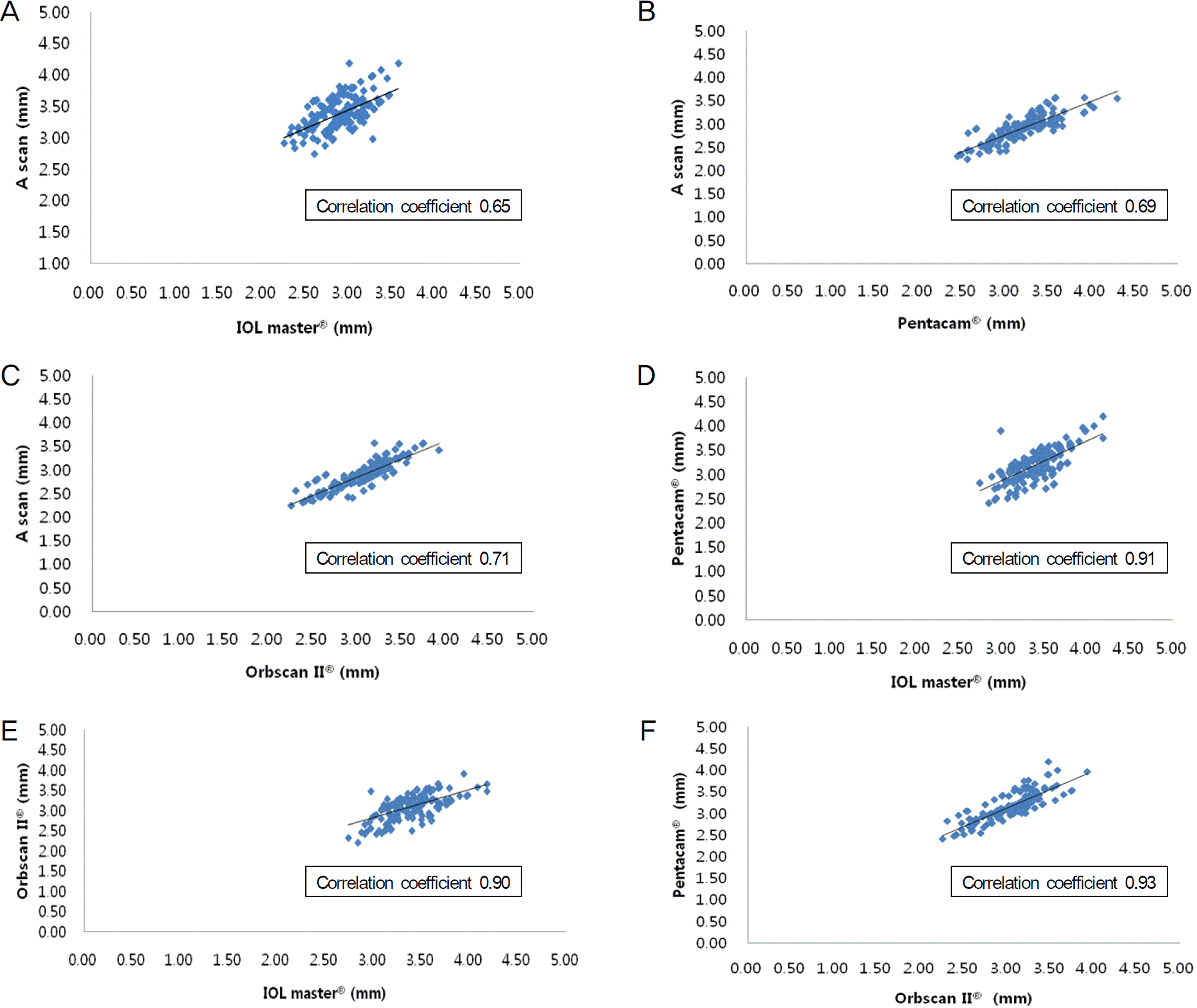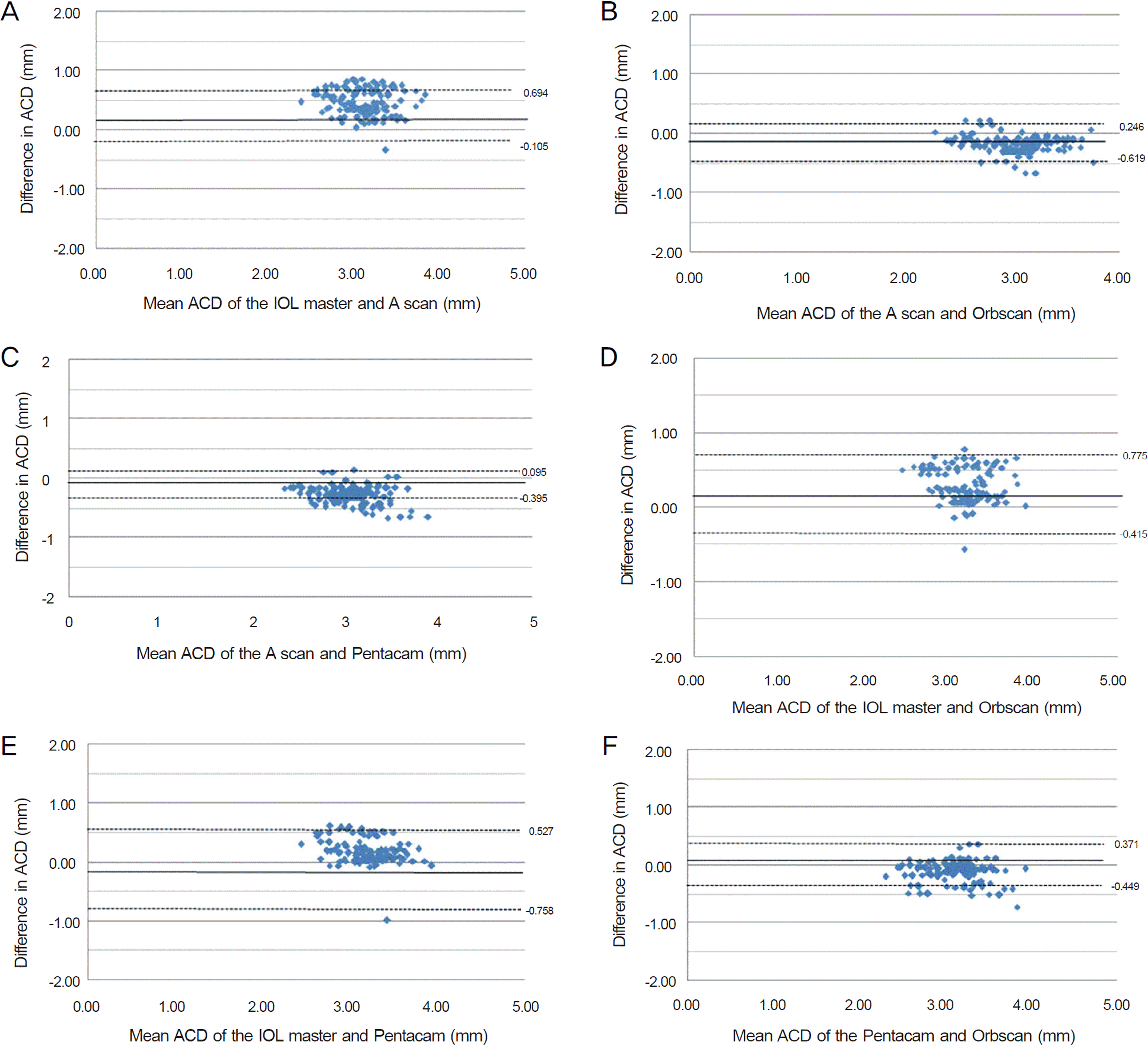Abstract
Purpose
To assess the reproducibility and reliability of applanation A-scan ultrasonography (Pacscan 300A, Sonomed Inc., Chicago, IL, USA) and optical measurements with IOL Master® (Carl Zeiss Meditec, Germany), Pentacam® (Oculus, Wetzlar, Germany), and Orbscan II® (Orbtek Inc., Laredo, TX, USA) when measuring anterior chamber depth (ACD).
Methods
In this study of 188 eyes of 94 patients, ACD estimation prior to cataract surgery was preformed by the applanation A-scan method and IOL Master®, Pentacam®, and Orbscan II® optical methods. Repeatability from each device was evaluated by coefficient of variation, standard deviation, and intraclass correlation coefficient. RM-ANOVA on Ranks was used to compare the differences in ACD among the devices. The Bland-Altman plot was performed to assess agreement in measurements between the devices.
Results
The mean ACD according to the applanation A-scan method and IOL Master®, Pentacam®, and Orbscan II® opti-cal methods were 2.89 ± 0.49 mm, 3.25 ± 0.45 mm, 3.21 ± 0.46 mm, and 3.19 ± 0.47 mm, respectively, and the differences were statistically significant (p < 0.01). The coefficient of variation for the 4 methods was 2.50% in the A-scan, 0.87% in the IOL Master®, 1.25% in the Pentacam®, and 1.04% with Orbscan II®, and reproducibility was higher with the optical principle devices. The correlation coefficient between A-scan and IOL Master® was 0.65, between IOL Master® and Pentacam® 0.91, between IOL Master® and Orbscan II® 0.90, between A-scan and Pentacam® 0.69, between A-scan and Orbscan II® 0.71, and between Pentacam® and Orbscan II® 0.93.
Conclusions
Applanation A-scan provided lower measurements for ACD compared with IOL Master®, Pentacam® and Orbscan II®. There was good agreement between results obtained with the latter 3 methods, and reproducibility was high with optical measurements. The coefficient of variation was low for IOL Master®.
References
1. Olsen T. Sources of error in intraocular lens power calculation. J Cataract Refract Surg. 1992; 18:125–9.

2. Holladay JT. Standardizing constants for ultrasonic biometry, kera-tometry, and intraocular lens power calculations. J Cataract Refractive Surg. 1997; 23:1356–70.

3. Alió JL, de la Hoz F, Pérez-Santonja JJ. . Phakic anterior cham-ber lenses for correction of myopia; a 7-year cumulative analysis of complications in 263 cases. Ophthalmology. 1999; 106:458–66.
4. Holladay JT. Refractive power calculations for intraocular lenses in the phakic eye. Am J Ophthalmol. 1993; 116:63–6.

5. Reddy AR, Pande MV, Finn P, El-Gogary H. Comparative estimation of anterior chamber depth by ultrasonography, Orbscan II, and IOL master. J Cataract Refractive Surg. 2004; 30:1268–71.
6. Vetrugno M, Cardascia N, Cardia L. Anterior chamber depth meas-ured by two methods in myopic and hyperopic phakic IOL implant. Br J Ophthalmol. 2000; 84:1113–6.

7. Shyn KH, Lee HK, Kim HS, Chung TB. Biometric analysis of an-terior segment of the eye with scheimpflug camera according to the type of cataract. J Korean Ophthalmol Soc. 1993; 34:105–10.
8. Choi JH, Roh GH. The reproducibility and accuracy of biometry parameter measurement from IOL master. J Korean Ophthalmol Soc. 2004; 45:1665–75.
9. Kim HJ, Kim HJ, Joo CK. Comparison of IOL Master, A-scan and Orbscan II for measurement of axial length and anterior chamber depth. J Korean Ophthalmol Soc. 2003; 44:1519–27.
10. Koranyi G, Lydahl E, Norrby S, Taube M. Anterior chamber depth measurement: A-scan versus optical methods. J Cataract Refract Surg. 2002; 28:243–7.

11. Auffarth GU, Tetz MR, Biazid Y, Völcker HE. Measuring anterior chamber depth with the Orbscan Topography System. J Cataract Refract Surg. 1997; 23:1351–5.

12. Jung TB, Shyn KH. Biometric analysis of the normal aged eye with phacoemulsification method. J Korean Ophthalmol Soc. 1992; 33:1060–4.
13. Rosa N, Lanza M, Borrelli M. . Comparision of central corneal thickness measured with Orbscan and Pentacam. J Refract Surg. 2007; 23:895–9.
14. Bae CY, Pae JH, Hong KY, Kim JD. A study on central corneal pa-chymetry maps with Orbscan Corneal Pachymetry System in Myopic eyes. J Korean Ophthalmol Soc. 2002; 43:1597–604.
15. Ryu HW, Kim RK, Chung SK. Comparison of A-scan, Scheimpflug camera, and Orbscan for measurement of anterior chamber depth. J Korean Ophthalmol Soc. 2006; 47:1287–91.
16. Su PF, Lo AY, Hu CY, Chang SW. Anterior chamber depth meas-urement in phakic and pseudophakic eyes. Optom Vis Sci. 2008; 85:1193–200.

Figure 1.
Correlation plot of anterior chamber depth measured by each device. (A) Correlation plot of anterior chamber depth measured by A scan and IOL MasterⓇ. (B) Correlation plot of anterior chamber depth measured by A scan and PentacamⓇ. (C) Correlation plot of anterior chamber depth measured by A scan and Orbscan IIⓇ. (D) Correlation plot of anterior chamber depth measured by IOL MasterⓇ and PentacamⓇ. (E) Correlation plot of anterior chamber depth measured by IOL MasterⓇ and Orbscan IIⓇ. (F) Correlation plot of anterior chamber depth measured by Orbscan IIⓇ and pentacam.

Figure 2.
Bland-Altman plots showing differences in anterior chamber depth measurements between devices. The upper and lower dashed lines indicate 95% limits of agreement, and the solid line indicates the mean.

Table 1.
Age and Sex distribution
| Age (years) | No. of Eyes | Total | |
|---|---|---|---|
| Male | Female | ||
| 30-39 | 4 | 4 | 8 |
| 40-49 | 14 | 12 | 26 |
| 50-59 | 22 | 24 | 46 |
| 60-69 | 32 | 32 | 64 |
| 70-79 | 12 | 14 | 26 |
| >80 | 8 | 10 | 18 |
| Total | 92 | 96 | 188 |
Table 2.
Anterior cham correlation coefficient
| A scan | IOL Master® | Pentacam® | Orbscan II® | p-value | |
|---|---|---|---|---|---|
| ACD (mm) | 2.89 ± 0.49 | 3.25 ± 0.45 | 3.21 ± 0.46 | 3.19 ± 0.47 | 0.138 |
| CV (%) | 2.50% | 0.87% | 1.25% | 1.04% | |
| ICC | 0.967 | 0.997 | 0.988 | 0.982 |
Table 3.
Results for the comparison of the anterior chamber depth measurements among devices




 PDF
PDF ePub
ePub Citation
Citation Print
Print


 XML Download
XML Download